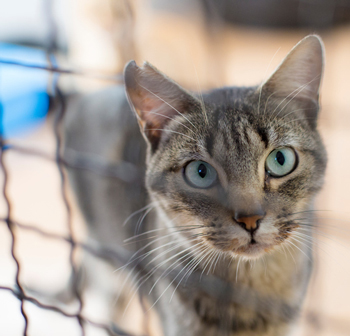Fishy Food and Feline Hyperthyroidism

Hyperthyroidism in cats is a disorder of the thyroid gland which results in excessive T3 and T4 hormone levels circulating in the blood. The high metabolism that this excess causes results in increased appetite, weight loss, vocalization, vomiting and diarrhea, and excessive thirst and urination.
You can learn more here: "Hyperthyroidism in Cats."
Cause of Hyperthyroidism in Cats
Hyperthyroidism was first described in cats in the 1970s. Since then, cases of the disease have continued to climb. While some of that may be due to veterinarians becoming more aware of it and diagnosing it more commonly and an increase in people seeking veterinary care for their cats, most scientists believe that the incidence of feline hyperthyroidism is increasing.
Unfortunately, the exact cause of this disease has not been identified yet, though there are many hypotheses.
Could Fishy Cat Food Cause Hyperthyroidism?
Researchers have noticed that cats with hyperthyroidism have higher levels of PCBs and PBDEs in their blood than cats without the disease (Jessica Norrgran, 2015). These chemicals are environmental pollutants. PBDEs are found in flame retardants, and they are banned in some countries. PCBs are an industrial chemical that was banned in the US but is still used elsewhere in the world and is found in fish.
A recent study on cats with hyperthyroidism found that the particular type of PCBs and PBDEs found in cats are probably derived from fish products rather than environmental exposure (Hazuki Mizukawa, 2015). Fish naturally produce and accumulate PBDEs, and they are found in high levels in both dry and canned cat foods (dry foods have higher amounts). PCBs are also found in dry and canned cat foods, especially fish-based ones.
It's possible that the PBDEs consumed by a cat compound those that she exposed to from being around flame retardants in furniture, carpeting, and bedding, increasing her potential for developing hyperthyroidism.
The way in which these chemicals may stimulate the development of hyperthyroidism is still not known, only that there is a connection.
Fish also contains a high amount of iodine, and that in itself may increase a cat's risk of developing hyperthyroidism.
Should You Avoid Feeding Your Cat Fishy Foods?
In light of this new research, it's probably a good idea to avoid feeding your cat fish-based dry or canned food.
Not only that, but there are other reasons to avoid feeding your cat diets heavy in fish, including exposure to mercury and the development of thiamine deficiency or steatitis (if tuna fish or other fish prepared for humans is used). You can learn more here: "Ethoxyquin, Mercury, and PCBs: Is Feeding Fish Safe for Cats?"
Fish is not a food that most cats evolved eating in the wild. Rather, rodents and small game have been the primary diet of cats in most areas of the world.
When you are deciding whether to feed fish to your cat, here are some tips to keep in mind:
- Don't use fish prepared for humans or fish-based cat foods as your cat's primary diet.
- If you feed your cat tuna fish, use chunk light in water rather than albacore, which has higher mercury levels. Use it as a treat occasionally, not as a primary food source.
- Cats can become addicted to fish and stop eating other foods if they have access to fish, so take care with how much of it you introduce into your cat's diet.
- If your cat already eats a lot of fish, start mixing some in with non-fish cat food to wean down to less or no fish.
- Check out our article "Flame Retardants and Hyperthyroidism in Cats" for ways to reduce your cat's exposure to environmental PBDEs.
Works Cited
- Jessica Norrgran, B. J. (2015, March 25). Higher PBDE Serum Concentrations May Be Associated with Feline Hyperthyroidism in Swedish Cats. Retrieved from Environmental Science and Technology: DOI: 10.1021/acs.est.5b00234.
You May Also Like These Articles:
Ethoxyquin, Mercury, and PCBs: Is Feeding Fish Safe for Cats?
Human Medications That Are Dangerous to Cats
Top 10 Cat Toxins of 2014 - Slideshow
Sago Palms Can Be Lethal to Cats
Warning: Topical Medications Containing Flurbiprofen May Be Dangerous to Cats
Notice: Ask-a-Vet is an affiliated service for those who wish to speak with a veterinary professional about their pet's specific condition. Initially, a bot will ask questions to determine the general nature of your concern. Then, you will be transferred to a human. There is a charge for the service if you choose to connect to a veterinarian. Ask-a-Vet is not manned by the staff or owners of CatHealth.com, and the advice given should not delay or replace a visit to your veterinarian.





